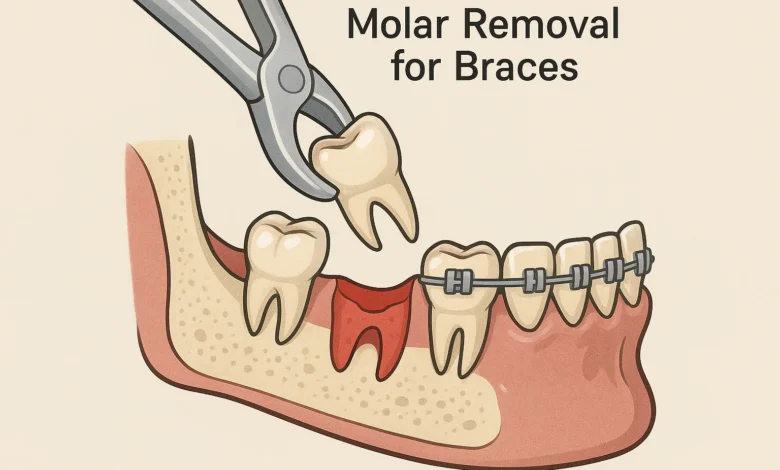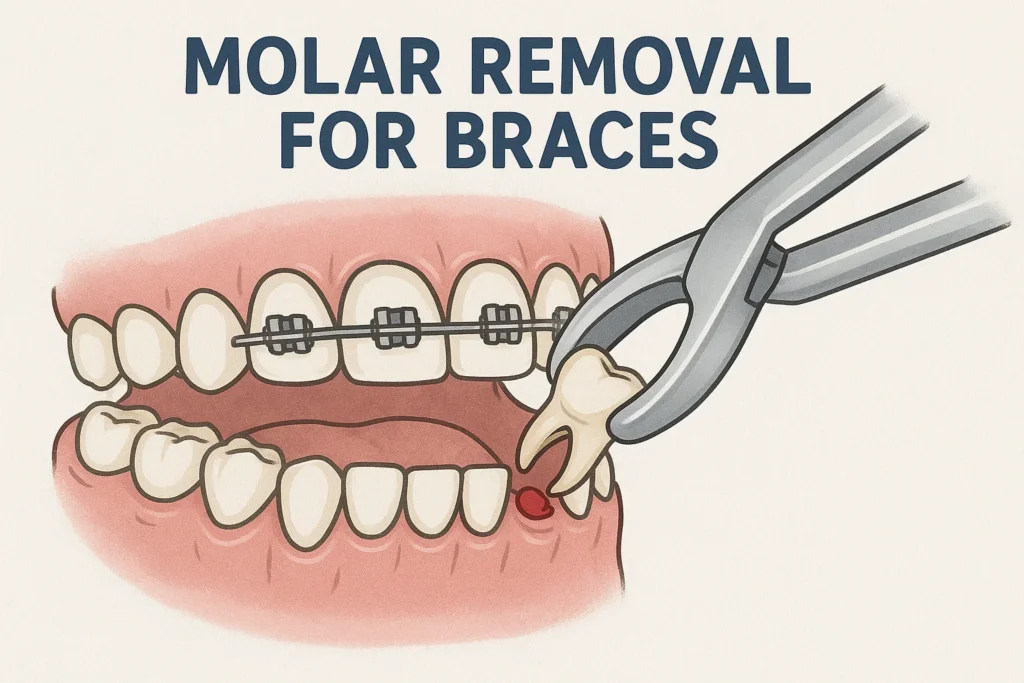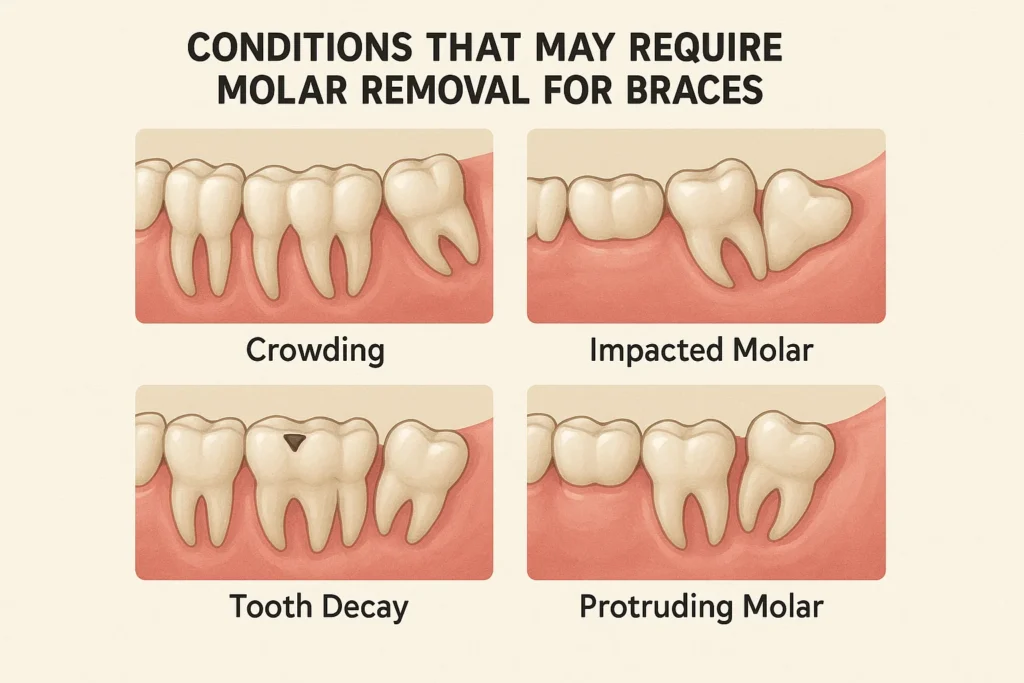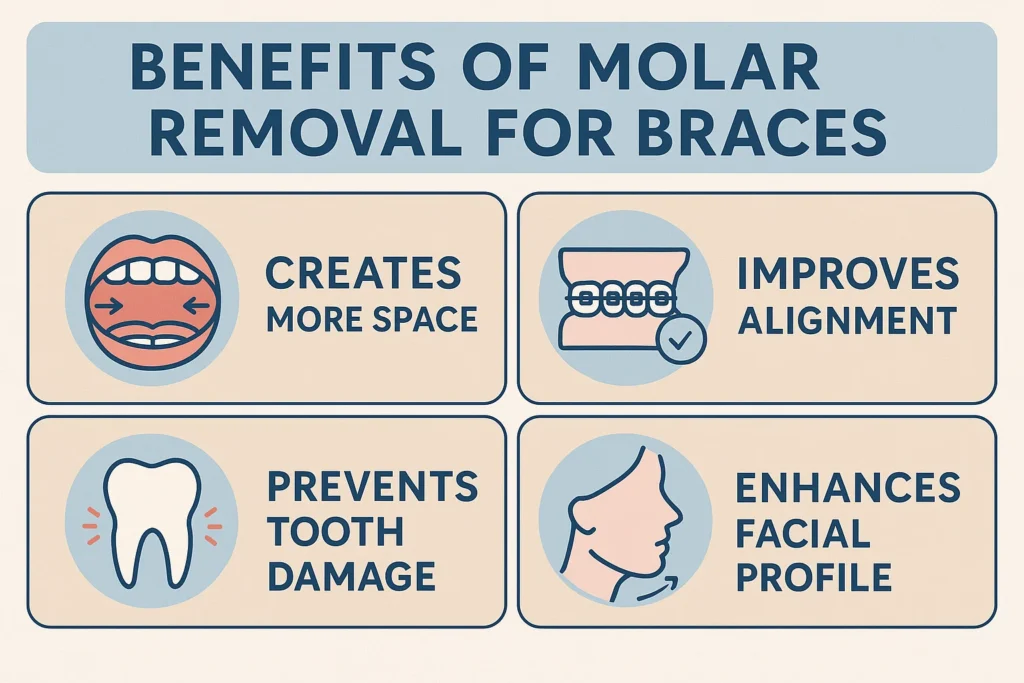Molar Removal for Braces: Is It Right for You?

Molar Removal for Braces: A Complete Guide to Understanding the Process and Benefits
Introduction
Braces serve as an excellent method to align your teeth while obtaining the perfect smile you have always desired. The orthodontic treatment process requires more than just metal bracket attachment to teeth in some cases. The procedure of molar removal for braces occurs frequently to guarantee successful orthodontic treatment. This article provides information about molar removal for braces including its necessity and procedure details and treatment effects.
This guide provides complete information about molar removal for braces including its purpose and advantages and disadvantages and surgical steps and post-operative care.
1. What is Molar Removal for Braces?

The process of molar removal for braces involves taking out one or multiple permanent molar teeth to create enough space for braces to properly align your teeth. The procedure becomes necessary when there is insufficient space in the mouth to achieve proper tooth alignment. The removal of molars creates essential space which allows the remaining teeth to achieve better positions.
Molar removal serves as a standard procedure within orthodontic treatment plans which may combine braces with expanders and retainers.
2. Why Is Molar Removal for Braces Necessary?
The necessity of molar extraction for braces treatment emerges when patients have serious alignment problems that prevent sufficient space for all teeth to move properly during orthodontic care. The removal of molars produces additional space in the jaw which enables better tooth positioning. The evaluation of specific factors determines whether molar removal should be performed.
Overcrowding
Your orthodontist will recommend molar removal when your teeth are crowded or misaligned because it creates additional space for the remaining teeth. The condition of overcrowding develops when teeth cannot properly align because the mouth lacks sufficient space so molar extraction becomes necessary to address this problem.
Bite Issues
The removal of molars becomes necessary when patients have bite problems including overbite or underbite or crossbite because their teeth and jaw do not align correctly. Orthodontists need to shift teeth significantly for proper bite correction so molar removal helps create enough space for tooth movement.
Insufficient Space
The removal of molars becomes necessary for patients with small or narrow jaws because it creates enough space for their other teeth to achieve proper alignment. The mouth does not provide enough space for proper tooth alignment even when all teeth are normal which makes it difficult for braces to work effectively.
3. Conditions That May Require Molar Removal for Braces

Overcrowding
Molar removal for braces occurs frequently because of overcrowding. The jaw does not contain sufficient space to accommodate all teeth properly which leads to this condition. The extraction of molars creates space for other teeth to achieve proper alignment so orthodontic appliances can direct the remaining teeth into their correct positions.
Bite Issues
The treatment of bite problems including overbite, underbite and crossbite requires advanced orthodontic procedures. The extraction of molars becomes necessary to achieve proper tooth and jaw alignment which results in improved bite function and comfort.
Insufficient Space
The narrow size of your jaw creates insufficient space for all your teeth to fit properly. The removal of molars in this situation produces space which enables the remaining teeth to achieve better alignment for more successful orthodontic treatment.
4. How Molar Removal for Braces Works
The process of molar removal for braces is straightforward but should always be done under the supervision of an orthodontist or oral surgeon. Here’s how the procedure typically works:
The Consultation
Before any removal, your orthodontist will perform a thorough examination, which includes:
X-rays to assess the position of your teeth and molars.
A discussion of your medical history and any potential risks.
Explanation of the procedure and the need for molar removal in your specific case.
After this, the orthodontist will determine if molar extraction is necessary for your treatment.
The Removal Procedure
Molar removal is typically a minor surgical procedure that is performed under local anesthesia. In more complex cases, general anesthesia may be used. The orthodontist or oral surgeon will:
Make an incision in the gum to access the tooth.
Remove the molar carefully using specialized tools.
Close the gum with sutures to promote healing.
The procedure is relatively quick, typically taking about 30 minutes to an hour, depending on the complexity of the extraction.
Post-Procedure Care
After the removal, your orthodontist will provide instructions on how to care for the extraction site:
Avoid hard or chewy foods for a few days to prevent irritation.
Take prescribed pain medications to manage any discomfort.
Ice packs may be applied to reduce swelling.
Proper care ensures that the healing process goes smoothly and that your braces treatment proceeds as planned.
5. Benefits of Molar Removal for Braces

Although the concept of molar removal might be intimidating, it has notable advantages in obtaining a perfect smile and bite alignment.
Improves Teeth Alignment
The removal of molars generates space in your mouth which enables your orthodontist to position your teeth exactly where they need to be. The procedure benefits patients who have teeth that are either crowded or not properly aligned.
Creates Space for Other Teeth
The removal of molars establishes necessary space which allows other teeth to be moved into their correct positions. The removal of molars enables orthodontic treatment to guide remaining teeth toward better positions when teeth are crowded or have erupted incorrectly.
Enhances Bite Function
The removal of problematic molars enables orthodontic treatment to properly position teeth which results in better bite function. The treatment produces a bite that functions naturally and efficiently.
6. Risks and Considerations for Molar Removal
While molar removal is generally safe, it’s important to understand the potential risks and considerations:
Pain and discomfort: You may experience swelling, bruising, or discomfort after the procedure. However, this usually subsides after a few days with proper care.
Infection: There’s a small risk of infection, so it’s important to follow the post-care instructions carefully.
Nerve damage: Though rare, nerve damage can occur, leading to numbness in the lip or chin area.
Gum recession: In some cases, molar removal may cause gum recession, which can affect the aesthetics of your smile.
It’s crucial to discuss these risks with your orthodontist to ensure that you’re fully prepared for the procedure and recovery.
7. Recovery After Molar Removal for Braces
Recovery after molar removal for braces is generally straightforward. Here’s what you can expect:
Healing Process
The healing process typically takes a few days to a week. Swelling and discomfort are common but can be managed with prescribed medications. Some minor bleeding may occur right after the procedure but it will stop on its own within a few hours.
Managing Pain and Discomfort
Your orthodontist will provide pain relief options, which may include:
Over-the-counter pain medications (Ibuprofen or acetaminophen).
Ice packs to reduce swelling and pain.
Saltwater rinses to help keep the area clean.
It’s important to follow these recommendations to ensure a smooth recovery process.
Dietary Restrictions
For the first few days following molar removal, your orthodontist will recommend a soft-food diet. Stick to foods like:
Soups
Yogurt
Mashed potatoes
Smoothies
Avoid hard, crunchy, or chewy foods that may irritate the extraction site.
8. Alternatives to Molar Removal for Braces
In some cases, molar removal may not be necessary. Your orthodontist might recommend alternative options to create space or improve alignment:
Palatal expanders: Used to widen the upper jaw and create space for teeth.
Tooth reshaping: Removing small amounts of enamel to make space for proper alignment.
Space maintainers: Devices that hold space for future teeth after early tooth loss.
These alternatives may be suggested depending on your unique dental situation.
9. How Molar Removal Affects Braces Treatment Time
The duration of braces treatment depends on whether patients choose to extract their molars. The removal of molars accelerates the entire treatment duration because it establishes additional space for teeth to achieve their correct positions.
The total treatment duration becomes shorter for patients who require molar removal because they already have available space. The duration of treatment depends on specific patient circumstances.
10. Cost of Molar Removal for Braces
The cost of molar removal for braces can vary widely based on factors like:
The complexity of the extraction.
The type of anesthesia used.
The region and orthodontist fees.
On average, molar removal costs range from $150 to $500 per tooth, depending on the factors involved. Your orthodontist will provide a more accurate estimate after a consultation.
11. Can You Avoid Molar Removal?
Not all cases require molar removal. In some instances, orthodontists can manage overcrowding or bite issues with alternative treatments. Early intervention can also help reduce the need for extractions by allowing for better space management in the jaw.
12. Frequently Asked Questions About Molar Removal for Braces
Q1: Do I really need to have molar removal for braces?
Your orthodontist will recommend molar removal if it is necessary to achieve proper results from your braces treatment. Some people do not need molar removal if their bite and teeth alignment can be corrected without it.
Q2: Is molar removal painful?
The procedure of molar removal takes place under local anesthesia which means you will not experience any pain during the treatment. You may experience some discomfort after the procedure which can be managed with prescribed pain medications.
Q3: How long will it take to recover after molar removal?
Most patients recover within a few days to a week. Swelling and discomfort usually subside within this period, and you can return to your regular routine within a few days.
13. Final Thoughts on Molar Removal for Braces
Orthodontic treatment requires molar removal as an essential procedure for patients who have crowded teeth or bite problems or insufficient jaw space. The procedure should not cause concern because it remains a standard and secure orthodontic practice which enhances treatment results.
You should consult an experienced orthodontist to determine if molar removal is necessary for your specific case.
Proper care and guidance during molar removal for braces procedures will help you obtain a straighter healthier smile in a shorter period.
Parts of Braces: Understanding the Key Components of Your Orthodontic Treatment



